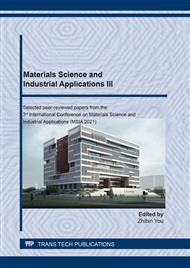p.163
p.172
p.178
p.186
p.195
p.201
p.207
p.213
p.220
Effect of Solid Solution Treatment on Corrosion Resistance of Al-Cu-Mg-Ag Alloy
Abstract:
In this experiment, Al-Cu-Mg-Ag alloy was used as material and solution temperature was used as variable to investigate its effect on the corrosion properties of the alloy and Hardness test, metallographic observation, electrochemical test, intergranular corrosion and exfoliation corrosion test were carried out on three groups of samples. The results show that the intergranular corrosion resistance of the alloy decreases with the increase of solution treatment temperature, and the sample treated at 505 °C has the best performance. This is mainly because grain boundary structure plays a role in increasing PFZ and expanding corrosion channels. The exfoliation corrosion resistance of Al-Cu-Mg-Ag alloy increases first and then decreases, and the sample treated at 515 °C has the best performance. This is due to the dual effects of grain boundary structure and grain morphology. On the one hand, the solution treatment temperature increases, which widens the precipitation-free zone and reduces the electrochemical corrosion resistance of the alloy. On the other hand, the increase of recrystallized grains decreases the cohesion of corrosion products and enhances the electrochemical corrosion resistance of the alloy.
Info:
Periodical:
Pages:
213-219
Citation:
Online since:
May 2021
Price:
Сopyright:
© 2021 Trans Tech Publications Ltd. All Rights Reserved
Share:
Citation:


